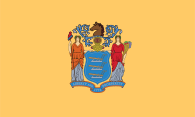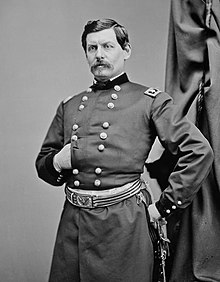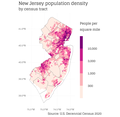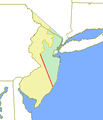The New Jersey Portal New Jersey is a state situated within both the Mid-Atlantic and Northeastern regions of the United States. It is the most densely populated of all 50 U.S. states, and is situated at the center of the Northeast megalopolis. New Jersey is bordered on its north and east by New York state; on its east, southeast, and south by the Atlantic Ocean; on its west by the Delaware River and Pennsylvania; and on its southwest by Delaware Bay and Delaware. At 7,354 square miles (19,050 km2), New Jersey is the fifth-smallest state in land area, but with close to 9.3 million residents as of the 2020 United States census, its highest decennial count ever, it ranks 11th in population. The state capital is Trenton, and the state's most populous city is Newark. New Jersey is the only U.S. state in which every county is deemed urban by the U.S. Census Bureau with 13 counties included in the New York metropolitan area, seven counties in the Philadelphia metropolitan area, and Warren County part of the heavily industrialized Lehigh Valley metropolitan area. New Jersey was first inhabited by Paleo-Indians as early as 13,000 B.C.E., with the Lenape being the dominant Indigenous group when Europeans arrived in the early 17th century. Dutch and Swedish colonists founded the first European settlements in the state, with the British later seizing control of the region and establishing the Province of New Jersey, named after the largest of the Channel Islands. The colony's fertile lands and relative religious tolerance drew a large and diverse population. New Jersey was among the Thirteen Colonies that supported the American Revolution, hosting several pivotal battles and military commands in the American Revolutionary War. On December 18, 1787, New Jersey became the third state to ratify the United States Constitution, which granted it admission to the Union, and it was the first state to ratify the U.S. Bill of Rights on November 20, 1789. (Full article...) Selected article -
The Jersey Shore shark attacks of 1916 were a series of shark attacks along the coast of New Jersey between July 1 and July 12, 1916, in which four people were killed and one injured. Since 1916, scholars have debated which shark species was responsible and whether one animal was involved. The attacks occurred during a deadly summer heat wave and polio epidemic in the northeastern United States that drove thousands of people to the seaside resorts of the Jersey Shore. Shark attacks on the Atlantic Coast of the United States outside the semitropical states of Florida, Georgia, and the Carolinas were rare, but scholars believe that the increased presence of sharks and humans in the water led to the attacks in 1916.
Local and national reaction to the attacks involved a wave of panic that led to shark hunts aimed at eradicating the population of "man-eating" sharks and protecting the economies of New Jersey's seaside communities. Resort towns enclosed their public beaches with steel nets to protect swimmers. Scientific knowledge about sharks before 1916 was based on conjecture and speculation. The attacks forced ichthyologists to reassess common beliefs about the abilities of sharks and the nature of shark attacks. Selected picture - Credit: KForce The Hackensack River is a river, approximately 45 miles (72 km) long, emptying into Newark Bay, a back chamber of the New York Harbor. The watershed of the river includes part of the suburban area outside New York City; it is separated from the Hudson River by the New Jersey Palisades. New Jersey news'Related portalsSelected biography -George Brinton McClellan (December 3, 1826 – October 29, 1885) was an American military officer and politician who served as the 24th governor of New Jersey and as Commanding General of the United States Army from November 1861 to March 1862. He was also an engineer, and was chief engineer and vice president of the Illinois Central Railroad, and later president of the Ohio and Mississippi Railroad in 1860. A West Point graduate, McClellan served with distinction during the Mexican–American War before leaving the United States Army to serve as a railway executive and engineer until the outbreak of the American Civil War in 1861. Early in the conflict, McClellan was appointed to the rank of major general and played an important role in raising the Army of the Potomac, which served in the Eastern Theater. (Full article...)Did you know? -
General imagesThe following are images from various New Jersey-related articles on Wikipedia.
TopicsQuality content
CategoriesThings you can do
For more information on how you can help, see the WikiProject New Jersey. Associated WikimediaThe following Wikimedia Foundation sister projects provide more on this subject:
Discover Wikipedia using portals |










































































